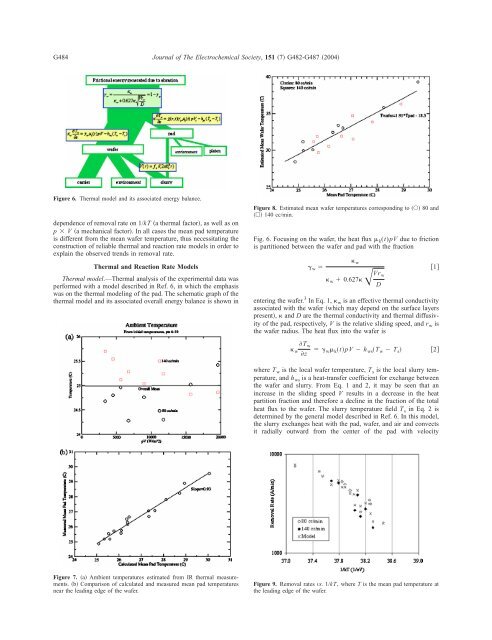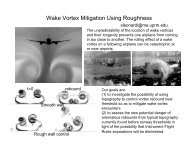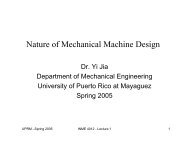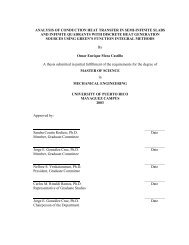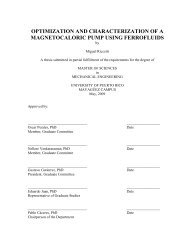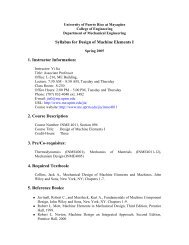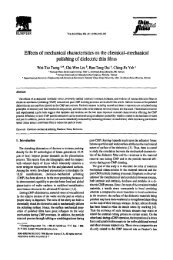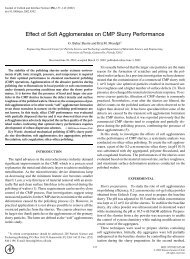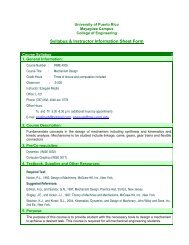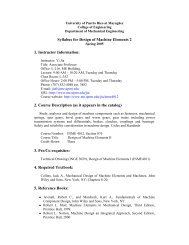Effect of Slurry Flow Rate on Tribological, Thermal, and Removal ...
Effect of Slurry Flow Rate on Tribological, Thermal, and Removal ...
Effect of Slurry Flow Rate on Tribological, Thermal, and Removal ...
You also want an ePaper? Increase the reach of your titles
YUMPU automatically turns print PDFs into web optimized ePapers that Google loves.
G484<br />
Journal <str<strong>on</strong>g>of</str<strong>on</strong>g> The Electrochemical Society, 151 7 G482-G487 2004<br />
Figure 6. <strong>Thermal</strong> model <strong>and</strong> its associated energy balance.<br />
dependence <str<strong>on</strong>g>of</str<strong>on</strong>g> removal rate <strong>on</strong> 1/kT a thermal factor, as well as <strong>on</strong><br />
p V a mechanical factor. In all cases the mean pad temperature<br />
is different from the mean wafer temperature, thus necessitating the<br />
c<strong>on</strong>structi<strong>on</strong> <str<strong>on</strong>g>of</str<strong>on</strong>g> reliable thermal <strong>and</strong> reacti<strong>on</strong> rate models in order to<br />
explain the observed trends in removal rate.<br />
<strong>Thermal</strong> <strong>and</strong> Reacti<strong>on</strong> <str<strong>on</strong>g>Rate</str<strong>on</strong>g> Models<br />
<strong>Thermal</strong> model.—<strong>Thermal</strong> analysis <str<strong>on</strong>g>of</str<strong>on</strong>g> the experimental data was<br />
performed with a model described in Ref. 6, in which the emphasis<br />
was <strong>on</strong> the thermal modeling <str<strong>on</strong>g>of</str<strong>on</strong>g> the pad. The schematic graph <str<strong>on</strong>g>of</str<strong>on</strong>g> the<br />
thermal model <strong>and</strong> its associated overall energy balance is shown in<br />
Figure 8. Estimated mean wafer temperatures corresp<strong>on</strong>ding to 80 <strong>and</strong><br />
140 cc/min.<br />
Fig. 6. Focusing <strong>on</strong> the wafer, the heat flux k (t)pV due to fricti<strong>on</strong><br />
is partiti<strong>on</strong>ed between the wafer <strong>and</strong> pad with the fracti<strong>on</strong><br />
w <br />
w<br />
w 0.627 Vr w<br />
D<br />
entering the wafer. 3 In Eq. 1, w is an effective thermal c<strong>on</strong>ductivity<br />
associated with the wafer which may depend <strong>on</strong> the surface layers<br />
present, <strong>and</strong> D are the thermal c<strong>on</strong>ductivity <strong>and</strong> thermal diffusivity<br />
<str<strong>on</strong>g>of</str<strong>on</strong>g> the pad, respectively, V is the relative sliding speed, <strong>and</strong> r w is<br />
the wafer radius. The heat flux into the wafer is<br />
1<br />
w<br />
T w<br />
z<br />
w k tpV h ws T w T s <br />
2<br />
where T w is the local wafer temperature, T s is the local slurry temperature,<br />
<strong>and</strong> h ws is a heat-transfer coefficient for exchange between<br />
the wafer <strong>and</strong> slurry. From Eq. 1 <strong>and</strong> 2, it may be seen that an<br />
increase in the sliding speed V results in a decrease in the heat<br />
partiti<strong>on</strong> fracti<strong>on</strong> <strong>and</strong> therefore a decline in the fracti<strong>on</strong> <str<strong>on</strong>g>of</str<strong>on</strong>g> the total<br />
heat flux to the wafer. The slurry temperature field T s in Eq. 2 is<br />
determined by the general model described in Ref. 6. In this model,<br />
the slurry exchanges heat with the pad, wafer, <strong>and</strong> air <strong>and</strong> c<strong>on</strong>vects<br />
it radially outward from the center <str<strong>on</strong>g>of</str<strong>on</strong>g> the pad with velocity<br />
Figure 7. a Ambient temperatures estimated from IR thermal measurements.<br />
b Comparis<strong>on</strong> <str<strong>on</strong>g>of</str<strong>on</strong>g> calculated <strong>and</strong> measured mean pad temperatures<br />
near the leading edge <str<strong>on</strong>g>of</str<strong>on</strong>g> the wafer.<br />
Figure 9. <strong>Removal</strong> rates vs. 1/kT, where T is the mean pad temperature at<br />
the leading edge <str<strong>on</strong>g>of</str<strong>on</strong>g> the wafer.


